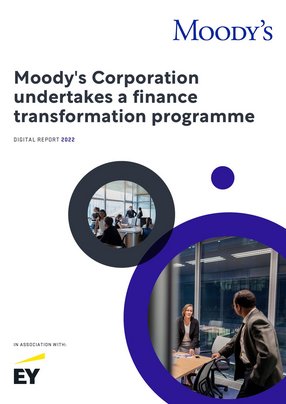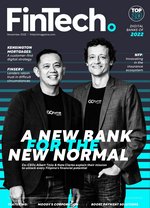Moody's people drive its finance transformation programme
Who better to introduce the business of globally recognised financial ratings organisation Moody’s Corporation than its Chief Financial Officer (CFO), Mark Kaye?
“Our mission is to provide trusted insights and standards that help decision makers act with confidence. In support of the corporate mission, within finance we strive to advance Moody’s business strategy by providing best-in-class, near real-time financial reporting and data-driven insight, mutually enabled by operating effectiveness.”
Moody's finance and operations – and within that, the company's enablement organisation – are led by Managing Director Jeff Klebanoff. “We focus on finance transformation, global business services, our automation and analytics strategy, but, first and foremost, we focus on our people and culture. We have a very broad, diverse group of folks working on transformation and enablement activities across Moody's.”
Data management and analytics are crucial to providing insights to the business. “In finance, data is key, but we are interested in the story that lies behind the data. We have a lot of focus on deciding what the right business information (BI) tools are to ensure that we can transform data, visualise it, and help people to analyse it – and it's really important that they understand what the numbers are telling us. One of the key responsibilities of being a business partner is to help them leverage the data to make the right decisions for the business units.
“Finance is no longer about reporting on what has already happened. Now, we're trying to shift the emphasis and reporting in a way that enables the business to be proactive, leveraging the numbers to predict what might happen – moving from hindsight to insight.”
“As such, a core priority of the company is upskilling employees to help them understand where data is stored and how it is governed, making sure the data is of good quality and presented in a way that allows our stakeholders to understand the insights about their business, their numbers, and their people. That way, the company can be sure it's presenting the best quality and most useful information. It's not merely about efficiency, it’s really about value-driven insights,” Klebanoff says.
Moody's Global Business Services is an organisation recently created to bring together 'value stream organisations' such as accounts payable, billing, collections and cash application. “If you consider our location strategy for finance, and how we manage our third parties, these and other services have become very focused on controls and the automation of controls. To make our clients' value drivers more efficient, we have to make the experience better, not just for our people, but for the ones who are actually using our services. They want to make sure their bills are getting paid on time, the customers are getting accurate information, or we're collecting the appropriate amounts and interacting effectively with our sales people and with our customers. We need to make sure that that's an effective, efficient process so we can keep a close eye on the KPIs and address issues they may be facing.
“How do we make sure that experience is a good one for everybody? How do we give people more time? How do we make it easier to get things done? How do we eliminate that non-value-added time with process improvement, or automation – or even the elimination of processes? Transparent transformation doesn't happen overnight. It's something we put in place, enable, and then take time to stabilise and optimise.”
Jeff Klebanoff and his team have put a Process Excellence Program (PEP) in place to address this. It focuses on enabling the business to execute on their own projects, while providing support by leading end-to-end projects and offering stakeholders a suite of tools, templates and self-paced learning, alongside mentoring to improve project success and full lifecycle project management support. “This is something at the centre of finance transformation for us. Value drivers are going to be at the heart of all the work we're doing as a finance organisation.”
People and the culture of transformation
Mark Kaye introduces the corporation-wide initiative that is being focused on here.
“To execute on our finance mission, we launched the Finance Transformation programme in 2019. This initiative aims to complement the implementation of modern technology solutions that enable heightened controls, efficiency, risk reduction, and data visualisation, ensuring that we attract and retain critical talent, while also focusing on continuous process improvement. As a result, over the last three years, we have re-imagined our finance operating model, standardised our global business processes, upskilled our employees and deployed enabling technologies, such as the SAP S/4HANA enterprise resource planning (ERP) system and Power BI dashboards, to deliver enhanced insights to our business stakeholders”.
“There is more to come, and we are very excited about the prospects ahead of us.”
Important as technology is, it's not everything – as Klebanoff reiterates: “You can’t scale intelligent automation and robotic process automation (RPA) without the people and the culture. One of the main areas of focus when we think about transformation is the people aspect. How do we ensure that the people are part of the transformation? Are they ready for and do they understand the change? Are they equipped with the skills to participate? We've embarked on a people journey, as well as a digital journey.
“We're busy upskilling, having realised we didn't have enough people who were strong in some of these new analytics and BI tools. We didn't have people who were really focused on the process. Some of them were unfamiliar with the SAP system we were putting in place – a lot of the traditional accounting that folks used to do changes when you automate, optimise and put in new systems. So, a very big emphasis has been placed on training; we created learning journeys aligned to the new roles required to support this enhanced finance organisation. When someone needs to develop a skill set, we give them the appropriate curriculum, as well as opportunities to put into practice – I believe this is essential to successful transformation."
“In a transformation, it's easy to concentrate on new systems and processes, missing the importance of people. We have to hire people and engage with partners to help us. Where we find a gap in our capabilities, we can work with partners like EY to fill them until we can hire or train people with these skill sets.”
The people journey, Klebanoff emphasises, will never be entirely complete, continuing to evolve as new tools and processes come along and finance transformation proceeds.
Delivery and partnership
That all-important Process Excellence team is overseen by Senior VP Paul Paretta, in addition to programme delivery across the business. With 11 years at Moody's, Paretta has a broad portfolio of responsibilities, overlooking all the projects and programmes across the finance organisation.
“My team has a key role in helping deliver and drive those projects. As part of that, we have a focus on mergers and acquisition integration, and there’s a core capability we have developed specifically for this.”
When it comes to onboarding and working with partners, the methodology varies depending whether the partner identified is a large system integrator (SI), such as EY, or a small, boutique-type business – though the principle remains consistent.
“Of course, we look for industry experience and for the competencies we need. That's a must-have for us: they need to have the track record to deliver; we want to partner with organisations that we can rely on to work with us through the ebbs and flows of a programme. Large-scale transformations are not easy and are often fraught with all sorts of risks and, in our industry, many fail.
“For us, it’s important to ensure that in the dark hours (those really tough times in delivering a programme), our partner will be there with us throughout the journey to help solve problems with us as part of the equation, in terms of the value-drivers of the programme. As we think about the organisations we've partnered with in the past and with whom we continue to partner, like EY, you will see this as a common theme.”
Scott Beltran, a Senior Partner at EY, explains how partnership helps to overcome the familiar headaches associated with M&A: “EY and Moody’s have worked together to develop an Integration Factory that can quickly integrate these acquisitions. The team is developed to be nimble, to expand and contract as needed while bringing together both institutional knowledge of Moody’s and the process, communication, training, and technical skills needed at the right time, as efficiently as possible.
“We constantly measure success against predefined goals and objectives specific to each programme. As it relates to the Integration Factory, we leverage a standard project plan across four predefined phases to monitor execution. At the end of each phase, we conduct a review of project status and risks and develop mitigation strategies where needed.
“In addition, we conduct weekly operational checkpoints across our stakeholder groups to communicate status, upcoming activities and provide a forum for concerns to be addressed. Success is measured through the successful execution of cutover and transition of users and processes to ‘business as usual’.”
However competent the team and its partners are, there will always be challenges along the way, as Paul Paretta is quick to admit. “We have an overarching, multi-year roadmap that helps us navigate the project portfolio across the finance organisation and serves as a way of communicating what work is committed and enables the right dialogue when prioritisation and trade-off discussions are needed.”
As Jeff Klebanoff stresses, technology is not enough on its own; it has to be absorbed into the culture of the organisation to drive the finance transformation journey.
Paretta explains: “We launched this programme back in 2019 and before we even started with the technology, we took a step back to assess how the finance organisation needed to change to support the broader organisation’s strategic goals and objectives. We refer to this as the digitisation of finance and we started by looking at the operating model and structure of the finance organisation. Clearly, technology is a significant component of this programme, it is the key enabler, but the people-perspective is at the heart of it all. Therefore, we ensured a key focus was on change management – we established a communications, training and engagement model that was thoughtful, intentional, timely and tailored to suit the varying needs of our stakeholders.”
A phased approach
Delivering significant change such as this has to be managed in a way that the organisation can effectively acclimate to new ways of working. As Paul Paretta describes: “We phased the programme into major releases. First, we rolled out enabling technologies within the SAP S/4HANA ecosystem; our global core footprint included a suite of capabilities in accounts payable, fixed assets, general ledger, consolidations and management reporting.”
“A key theme that cannot be emphasised enough is that these programmes are not easy to execute, and recognising when to adapt and pivot to changing circumstances has been a key success factor. We recognised the phasing strategy we initially set forth required even further decomposition. To that end, we introduced an additional phase which allowed us to de-risk and reduce the complexities of our next major release. In August 2021, we deployed customer billing, tax, accounts receivable, cash applications and revenue accounting to our Moody’s Analytics business. In 2023, we will kick-off deploying this same suite of capabilities to our Moody’s Investors Service business, which will benefit from the ‘global design’ we implemented during the second phase of the programme.”


